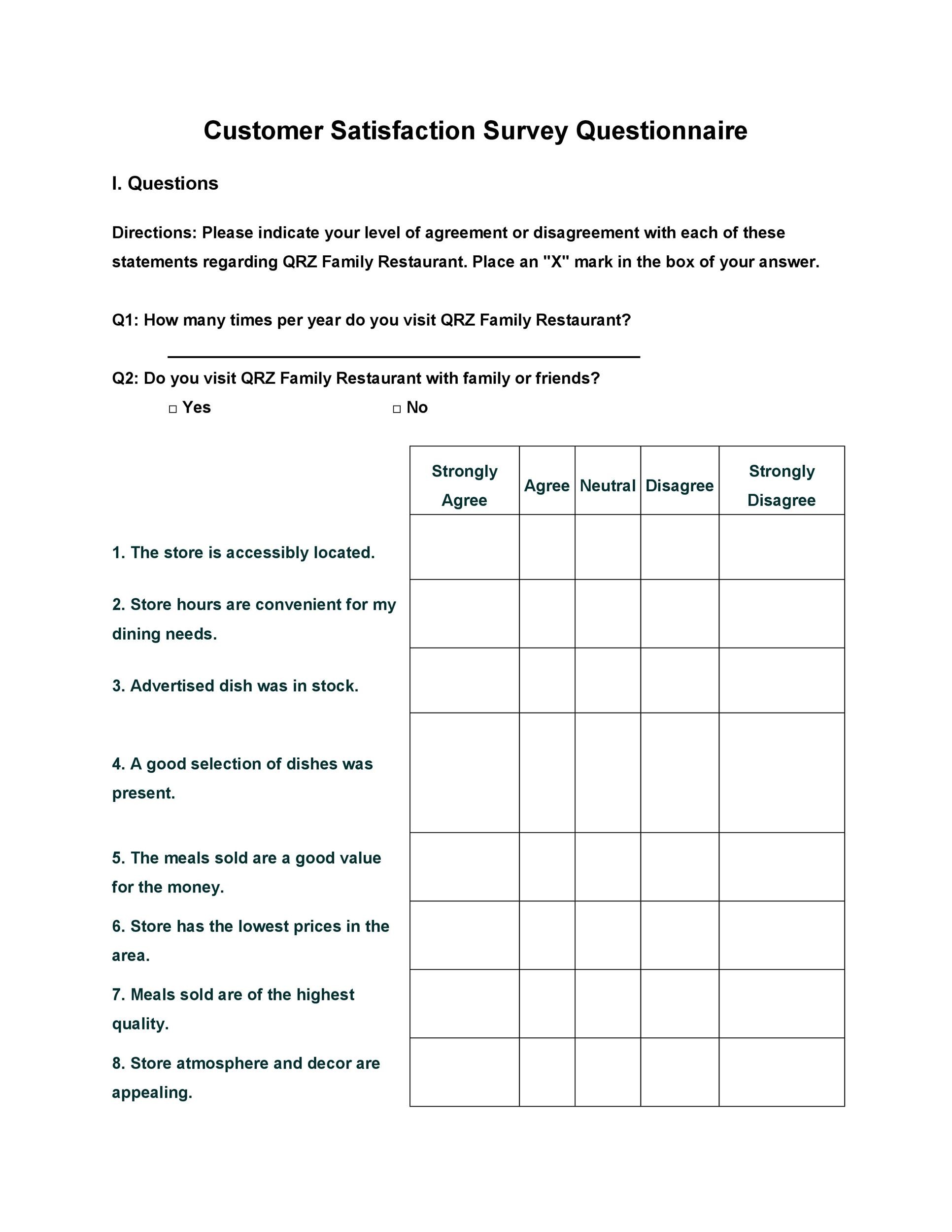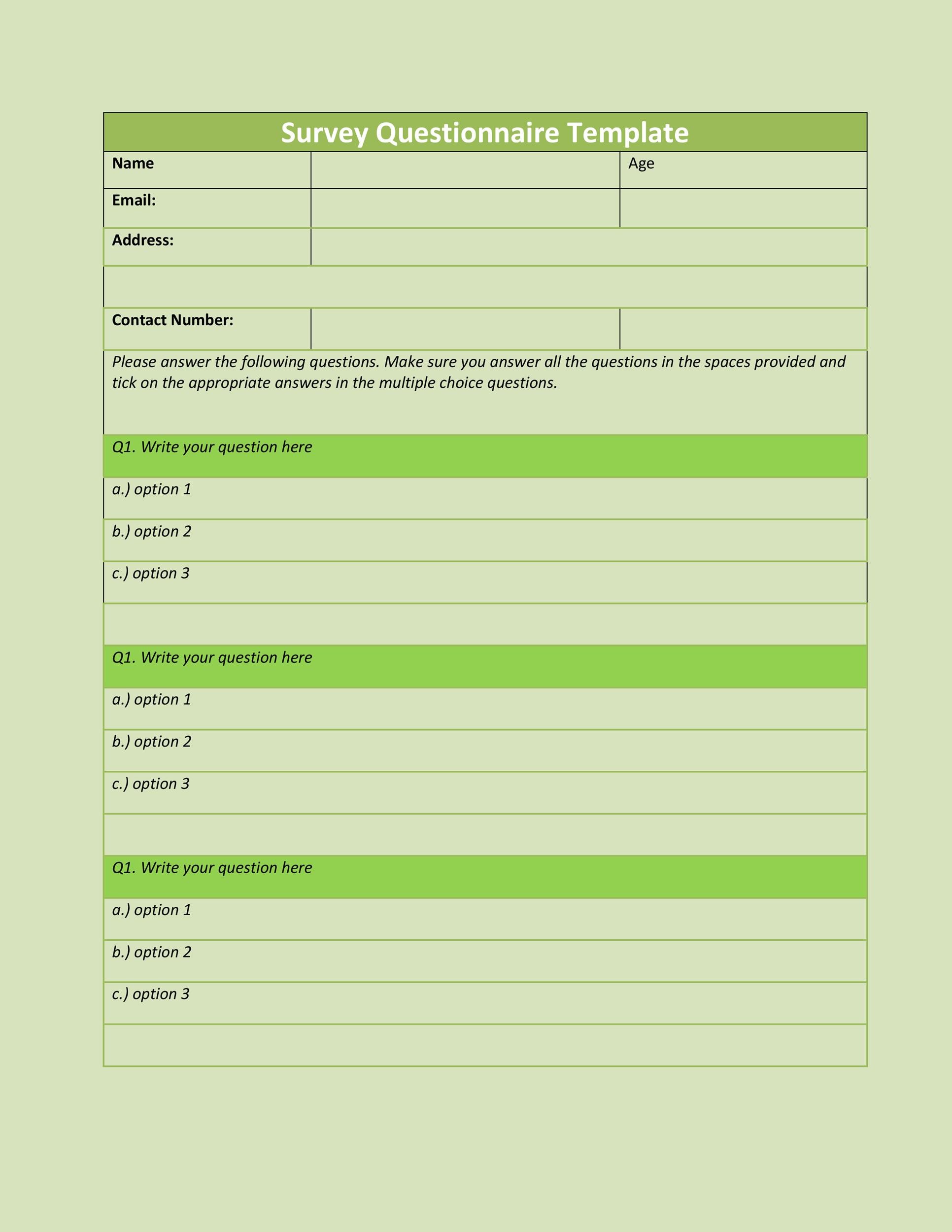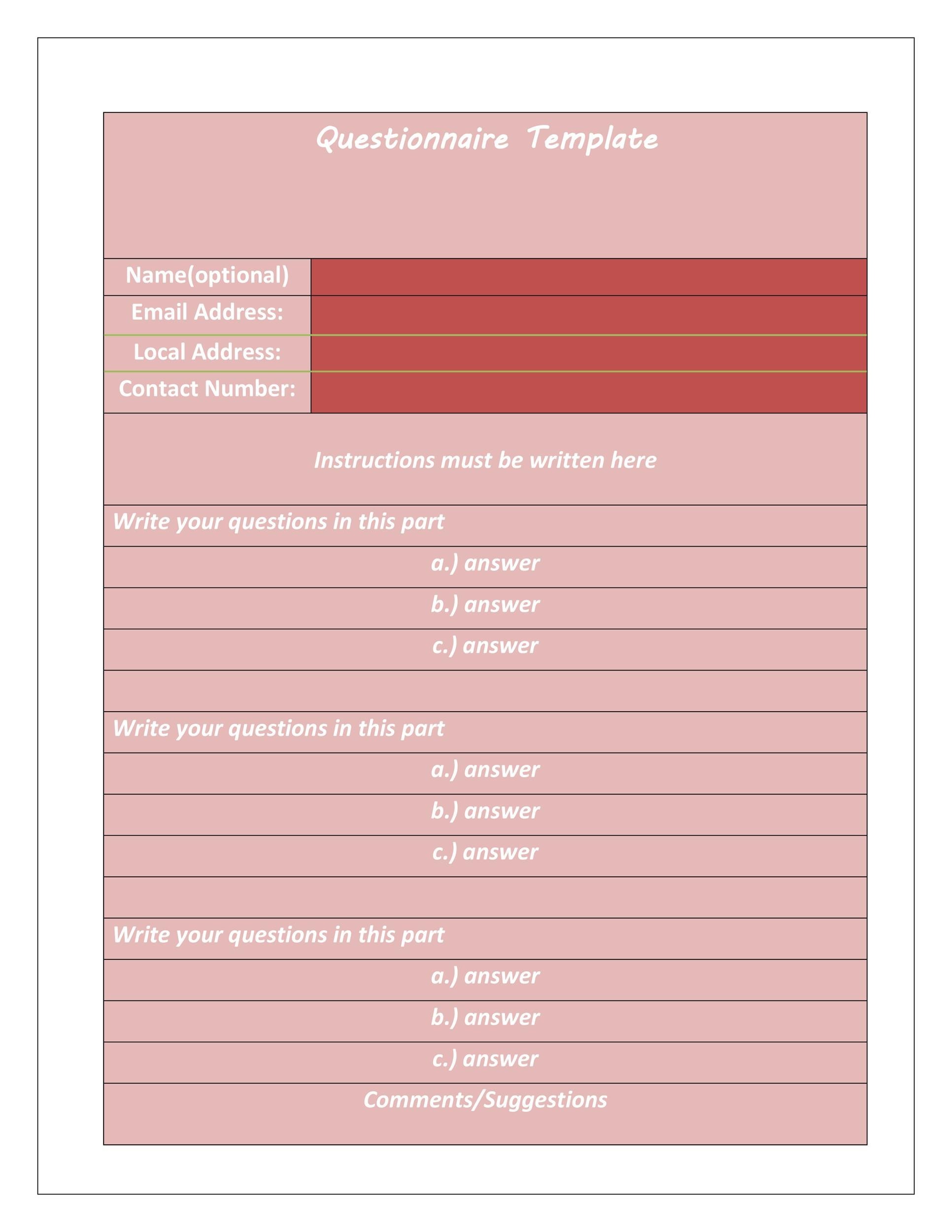If you’re looking to gain insights on your audience or customers, a questionnaire or social survey is a reliable method used to collect standardized data from large numbers of people. (All of the information is collected in the exact same way. Questionnaires are often used by the government to find out more information about geographic areas, the lifestyles of its citizens, and assess which programs get funded. Many government entities rely on questionnaires to run programs or fund certain initiatives. This is because surveys are a favorite way to collect data in a statistical form.
Table of Contents
A questionnaire is a powerful tool that provides the important function of eliciting the feelings, beliefs, perceptions, or attitudes of a group of individuals. In other words, to collect valuable and previously unknown data.
The questionnaire is most frequently a very concise, preplanned set of questions designed to yield specific information to meet a particular need for research information about a pertinent topic. The research information is attained from respondents normally from a related interest area. The dictionary definition gives a clearer definition: A questionnaire is a written or printed form used in gathering information on some subject or subjects consisting of a list of questions to be submitted to one or more persons.
Questionnaire Templates
How Do Businesses Use Questionnaires and Surveys?
Using a questionnaire to find out more about your customers or other stakeholders, as a business or organization, is essential to adequate audience research. You can use this information to get to know your audience better, plan communication with them, and even orchestrate campaigns tailored to the ideas you’ve surveyed them about.
How do you put this into practice, anyway? Well, let’s say, for example, Ted is a small business owner that sells upscale, designed umbrellas on his website. He has a few colorful designs, but he want to raise he prices in order to carry more choices of designer umbrellas. He also wants to sell a raincoat line and Tom wonders if his target customers will think it’s all too fancy.
In order to put his “feelers” out, Tom decides to incentivize a survey on his website asking questions from people who have previously purchased from him. All of the survey respondents will be entered into a raffle worth $100 on his website. Because of this, he gets over 200 responses. He’s able to ask the questions he needs about the potential product line he wants to add. When the response is overwhelmingly positive, he knows that the quantitative data he acquires is worth the wait.
Are you ready to get started? We have several Excel questionnaire templates available for download on this page as well as questionnaire templates for Word. They’re free to help you get started.
Or, alternatively, keep reading to learn more about how to put these templates to best use.
What Kinds of Surveys Work Best?
If you want to gather unique and powerful information about an audience, a survey can help you tailor your questions and gauge their reactions accordingly. The kind of information you are seeking will help you determine the type of surveys you want to put into motion.
Basically, there are three types of surveys that are used for research purposes. There are factual surveys, which are used to collect descriptive information, such as demographic information that is used by the government to collect data. Attitude surveys, often called opinion polls, attempt to collect and measure people’s attitudes and opinions. Explanatory surveys go a step further in seeking out opinions. They’re designed to test theories and hypothesis as well as form new theories.
Essentially, the type of survey or questionnaire you choose will be tailored to your project. If you’re looking to capture the attitudes of young voters across America, then you may want to offer multiple-choice questions to allow them to explain their levels of interest and involvement in certain issues.
Researchers usually use questionnaires to make data-driven generalizations about attitudes, opinions, and behaviors. Because of this, you must be very careful when choosing whom you will be surveying, such as your customers or donors. These carefully selected samples should reflect the diversity of your base in order to be as accurate as possible. In fact, most often, a survey therefore, the surveys are usually based on carefully selected samples.
There are also many types of questionnaire templates for Excel and Word that may fit your purposes. We have several templates available for free download on this page.
Questionnaire Examples
Choosing Your Template By The Questions Your Survey Asks
If you’re getting ready to design a questionnaire, you will want to know some of the basics about survey design. The type of questions you will be asking your participants will decide the design of your survey and questionnaires, in part. Keep in mind that a neat, clean document design is also important for practical purposes; after all, a disorganized survey can be a pain for both the participants as well as the researcher.
There are basically two kinds of questionnaires that are used by researchers. Closed or restricted form surveys, which simply ask “yes” or “no” answers, or multiple choice-type questions, are known for being fairly easy to interpret and summarize. The second type of questionnaire, called an open or unrestricted survey, allows respondents to answer freely as they see fit. While these types of surveys are great for learning in-depth about the users and their thoughts, they can also be difficult to interpret and summarize.
Restricted surveys will work great with our Excel Questionnaire templates, while you may choose a Microsoft Word questionnaire template to ask users open-ended questions.
Choosing Your Questions Carefully
A questionnaire template is only as good as the questions you are asking. Sometimes a survey will include what is essentially a “loaded question”, meant to skew the results one way or another. This is often used by biased news sources or politicians who want to portray a public opinion that aligns with their views. This is great for propaganda purposes, but for actual, scientifically sound research on opinions, you’ll want to use questions that can be answered in a way that will truly reflect the views of your respondents.
When writing out the questions you will ask, keep the following questions in mind for yourself:
- Is each question you’re asking truly necessary?
- How will the answers to the questions be used?
- How will the answers to your questionnaire be analyzed, and interpreted?
- How many questions are truly needed? (Anything over 10 may have a high drop-out rate)
- Do questionnaire respondents have the information/experience necessary to answer your questions?
- Is the question written in a clear way, with no bias or emotional overtones?
- Will the survey respondents feel comfortable answering the question honestly?
- Could the wording of the question possibly offend or put-off respondents?
- Are you going to ask direct or indirect questions?
- If a checklist is used, do you have a wide range of answers to choose from? Or are you forcing opinions on somebody?
- Is the answer to any of your questions likely to be influenced by prior questions you’ve asked? (If so, you may want to change the order up to keep participants from drawing conclusion.)
Your questionnaires should all be exactly alike, unless you’re testing the survey itself to see which one gets the most responses. Questionnaires used on a template should consist of the same set of questions, asked in the same order every time.
Questionnaire Samples
Getting the Answers and Responses You Need For Your Research
When conducting research, you can either have the participants fill out the surveys themselves, or you can have researchers interview participants over the phone or face-to-face.
If you’re having your respondents fill out the questionnaire, you may want to incentivize filling it out and returning it. Consider giving a coupon reward or holding a raffle for a gift certificate. Each person who returns their form by a certain date will get a chance at these rewards. Also consider which mode of deliver you find most useful.
Postal questionnaires can be used, but you’ll want to make sure you can count on the group returning their answers and to the researcher by a specified time and date. Telephone questionnaires can be set up to robocall, but most people find them annoying so they tend to be ineffective. You could also use your printed questionnaire to administer the questions to a group. For example, you may want to survey members of a certain club or organization. If you choose this option, be aware that groups tend to hold a bias when they fill out questionnaires in the same room together and tend to also have trouble concentrating on the task at hand when in the presence of their social circle.
Some forms of surveys will be done on the Internet with a link emailed to the questions. This is a very simple way to do our research. You can keep this data tabulated in a structured way by using an Excel questionnaire template, or you can choose to use a plain old pen and paper to tabulate your responses.
Another way to conduct surveys and questionnaires is to have the questions asked in a structured and formal way by an interviewer in a setting where each participant is interviewed one at a time. The greatest advantage of this type of research is that the interviewer can clarify any ambiguous-sounding questions and help if the respondent is confused in any way.
Why Are Questionnaires Better than Focus Groups?
Many marketers will use questionnaires and surveys to get vital information about their customer to use in their future marketing campaigns. Questionnaires are a great way to make audience segmentation easier; as long as you know which questions you need answer. They’re also much cheaper in comparison to other data-gathering methods.
Questionnaires and surveys are more economical than training interviewers and holding focus groups. Most focus groups will require some sort of compensation and there is always a chance of interview bias involved in them. Sometimes these groups can veer off-topic as well. For this reason, having respondents fill out their own surveys gives you, as a researcher, more control over the results and guaranteed answers to your question.
When you design your questionnaire in Word, you’ll want to pay attention to the uniformity of the questions. Through this, questionnaires may give you more data than most in=person meetings or interviews. You can still guide the readers toward an answer if you are not careful, but at least make sure that the questionnaires are uniform, asking the same questions, in the same order, in the same way. If the questions are highly structured, and you provide multiple choice answers, then the survey you are working with is standardize and therefore more likely to answer the deeper questions surrounding the research h you are doing.
Please keep in mind, when designing your surveys and using Word or Excel templates, that a random sampling is the best way to distribute a survey. By asking a random group of customers or people in a certain demographic or geographic area, you will be able to rule out biased samples. If you are using incentives to entice people to respond to your survey, then you should realize that some people might only be participating in your survey to get the “prize”. Because of this, your survey may fall short and have biased respondents who may not even be totally honest about their opinions.
What Factors Affect The Response Rate of Your Questionnaires?
There are several factors to keep in mind as you begin to fill out your survey or questionnaire templates. There are a few things that can affect the outcome of a mailing or other campaign asking a sampling of people to respond. Ask yourself the following questions before doing any mailing, postal or email:
- What is the length of the questionnaire? Is it too long and consuming for most people to answer? Keep it to one page or less than ten questions to optimize responses.
- What is the reputation of the business or organization sending out the survey? If you’re a political organization known for a right or left-leaning ideology, you will likely have people who oppose your ideology that may ignore your survey or skew it on purpose.
- Are the questions too complex or have you simplified them to eliminate any ambiguities?
- Are the questions on a subject that the respondent may find important? Can you change the wording to reflect more urgency? When a respondent feels that their opinion is truly needed and important, they are more likely to answer your questions.
- What time of year are you sending your surveys out? Think about the timing of your mailing in relation to national and religious holidays. Don’t send a survey out to parents in the middle of summer vacation. It will sit unopened if they are out of town.
- Are you asking questions that only your sampling group can answer? Don’t overlap with publicly available information such as demographic data that can be easily found in free government sources such as the census.
Get the Most Out Of Your Questionnaire and Survey Templates
A good questionnaire deals with a topic that the recipient will feel is important and has opinions on. Each survey you send out should have an accompanying letter that explains why it’s important to spend time completing it. For example, if you’re a nonprofit surveying the community to decide where you will allocate funds this year within the community, you should explain how the answers would shape new programs that will provide vital services. The importance of the answers should be stated clearly and the cover letter should make a compelling introduction to the needs you have for the information.
Are you ready to get started with your own survey or questionnaire? We have free Word and Excel templates ready for you to download and start customizing today.







































